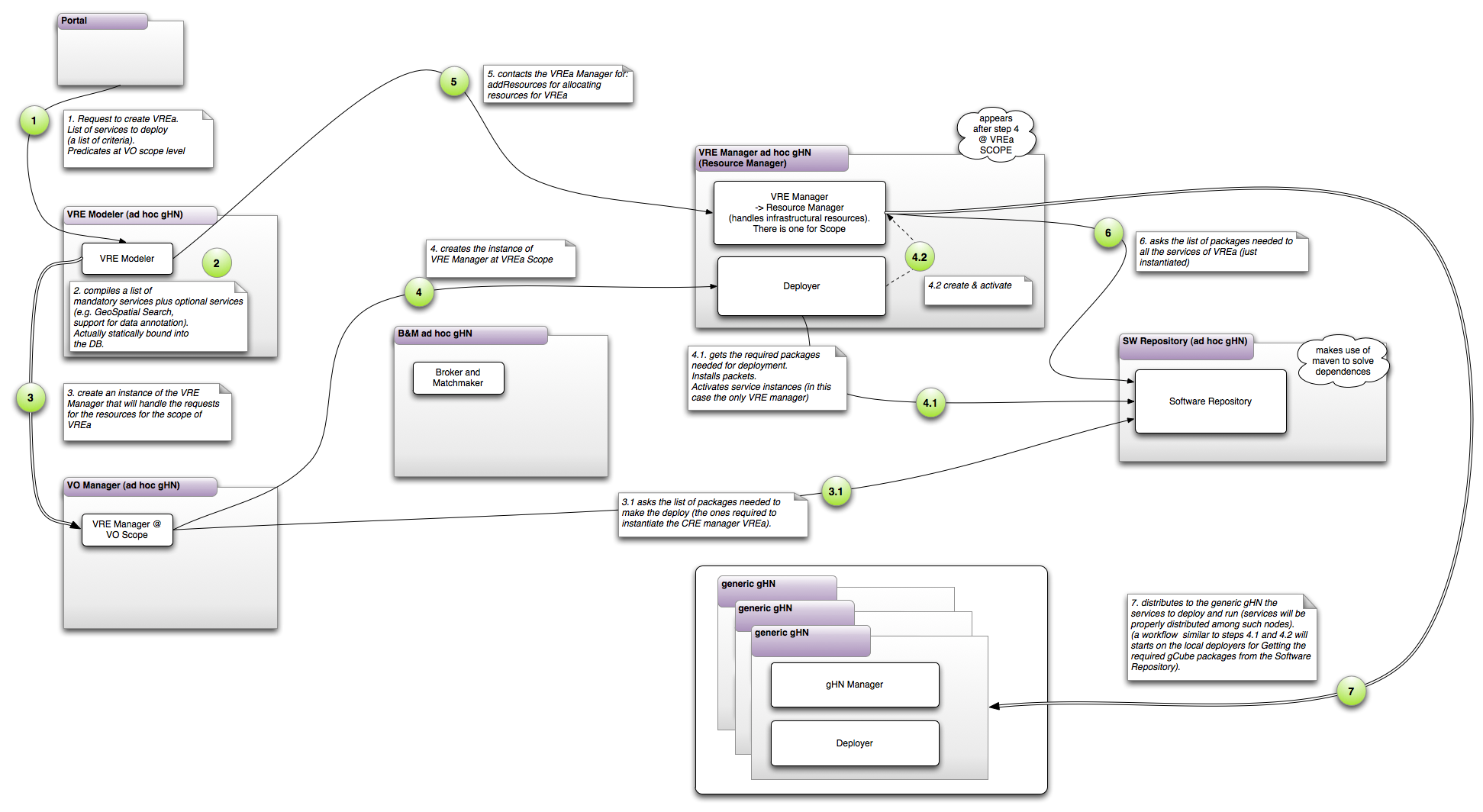Resource Broker
The Resource Broker represents an ad hoc gCube service promoting and supporting the optimal selection and usage of resources during the VRE deployment phase. In particular, it is invoked to select the most appropriate pool of gHNs to be used, among those available in the context of the VRE, during the deployment of the services needed to operate the VRE. Because of this, it interacts with:
- the Information System (IS) to be aware of the available gHNs as well as of their distinguishing features (e.g. the number of Running Instances currently hosted by it, the RAM the machine is equipped with) and
- with the Virtual Organisation Management (VO-Management) to act securely and filter out the gHNs that falls out of the operational context of the VRE. From an architectural point of view it mainly consists of a service implementing the matchmaking algorithm.
Deployment phase
Several steps are involved during the deployment of a VRE. The green circles are labeled with numbers representing the natural succession of actions. The labeled boxes are the actors by means of GHNs and the services instantiated on them that take part to the protocol (the other services published on such GHNs are omitted for a better readability). Finally the white box containing several GHNs depicts a typical situation where (a group of) generic GHNs are dedicated to host the freshly deployed VRE instances.
The Figure 1 reports a scenario of VRE instantiation. Here, we briefly recall the main steps that are performed (we assume to start from a request of VRE instantiation coming from the portal interface and that VREa is the name to assign to it):
- The portal requires the VRE Modeler to create a VRE (we call it VREa).
- Internally the VRE Modeler compiles a list of mandatory services plus optional services (e.g. GeoSpatial Search, support for data annotation). Actually these information are statically bound into the DB.
- The VRE Modeler accesses the VO Manager (a particular instance of VRE Manager defined at VO scope level) requesting to create an instance of the VRE Manager (Resource Manager of VREa) that will handle the requests for the resources for the scope of VREa.
- the VO Manager asks the Software Repository the list of packages needed to make the deploy (the ones required to instantiate the VRE Manager of VREa).
- The VO Manager asks the Deployer on the gHN of VRE Manager (Resource Manager of VREa) to create the instance of VRE Manager (at VREa Scope).
- The Deployer of VREa gets from the Software Repository the required packages needed for deployment. Installs packets. Activates service instances (in this case the only VRE manager).
- The Deployer of VREa creates and activates the VRE Manager of VREa (now the gHN of VREa is ready - VREa is instantiated).
- The VRE Modeler contacts the VREa Manager trough VRE Manager AddResources for allocating resources for VREa.
- VREa Manager asks the list of packages needed to all the services of VREa (just instantiated).
- VREa Manager distributes to the generic gHN the services to deploy and to run (services will be properly distributed among such nodes). A workflow similar to steps 4.1 and 4.2 will starts on the local deployers of generic gHN for getting the required gCube packages from the Software Repository.
Design
This Section will introduce the main concepts and the development strategies adopted at Resource Broker design phase.
Service architecture and code design
The whole project consists of several parts here summarized:
- contexts: a constraint for building Stateful WS-Resources in the gCube framework is that each service declares its own StatefulBrokerContext. Aside, the ServiceContext represents the context of each service instance and keeps no persistence. Both the contexts are managed by a ResourceBinder that properly instantiates and maintain them.
- resources: the SingletonResourceStorage is the singleton instance keeping the persistence of ResourceBroker status. For further details on how the state is mantained in gCube, refer to Building gCube Services Tutorial.
- types:
- services:
- threads:
- notifications:
- assertions:
- serialization:
- planbuilders:
